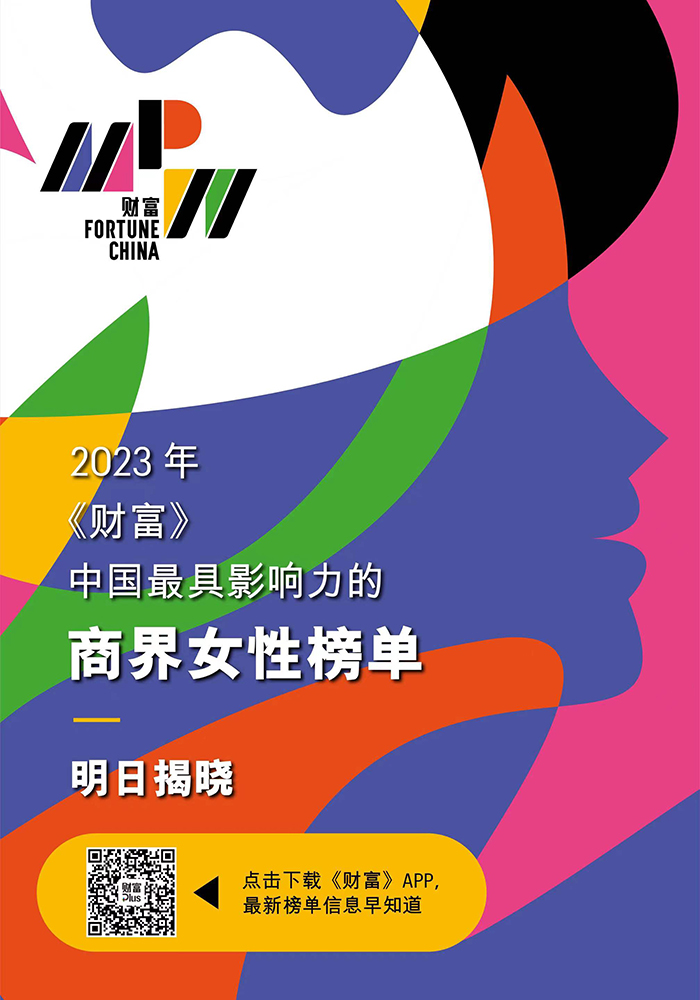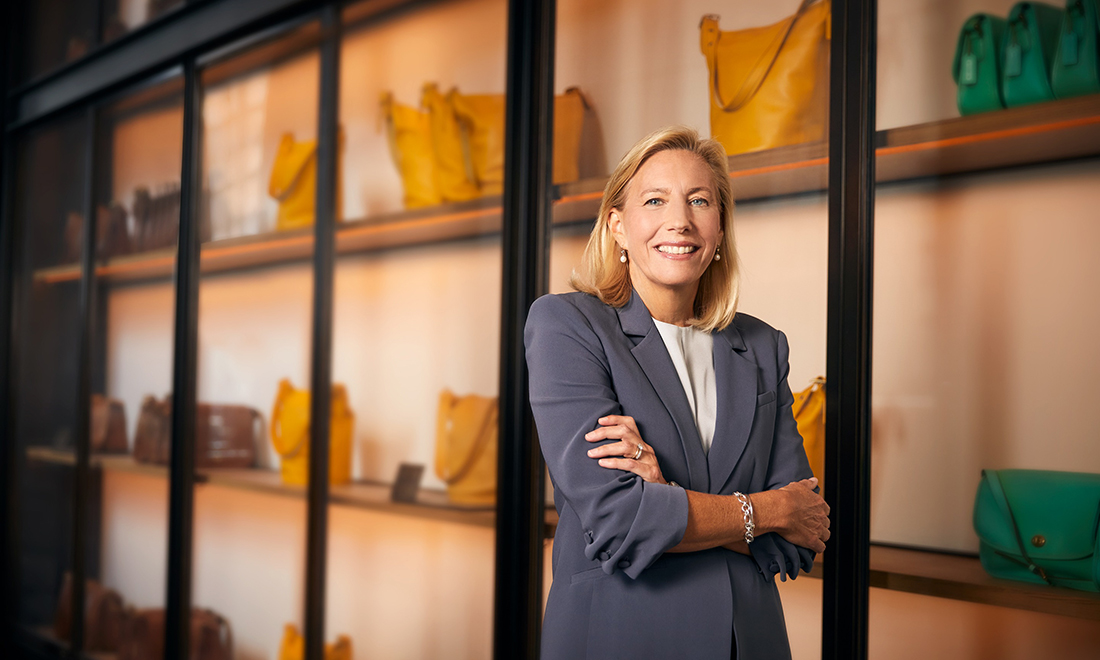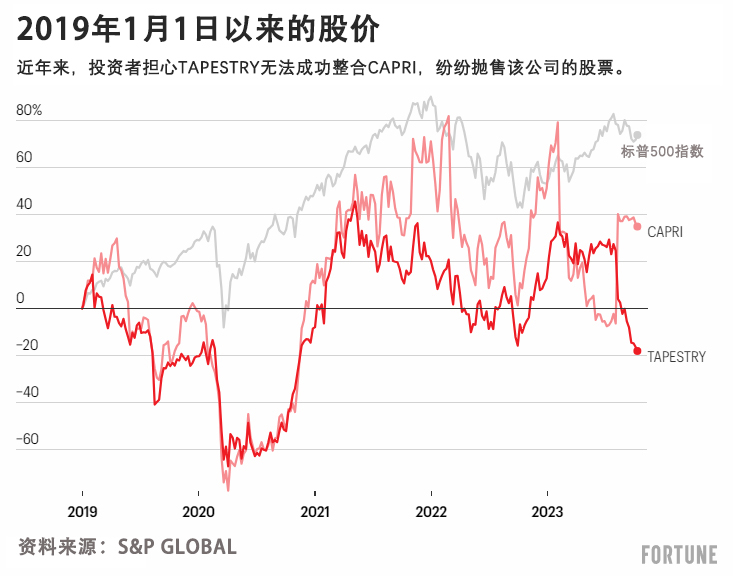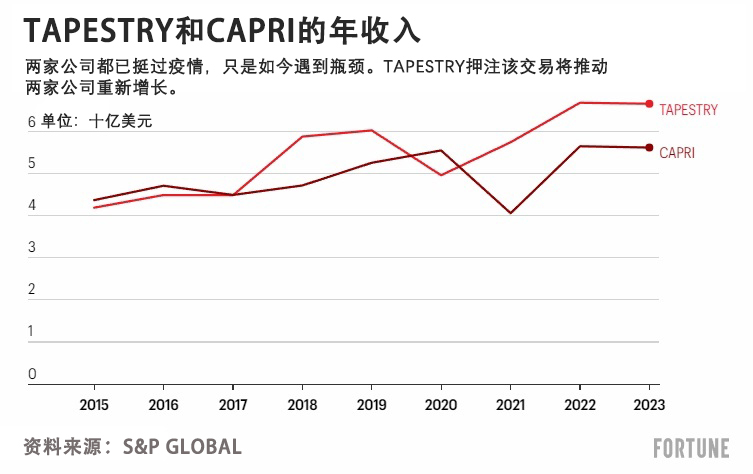編者語:
本文的主人公喬安妮·克里沃塞拉為人低調(diào),要被公關(guān)團(tuán)隊說服才愿意坐下來接受采訪,。
作為蔻馳母公司Tapestry的首席執(zhí)行官,,今年8月,她以85億美元(約合614億人民幣)收購競爭對手Capri Holdings。Capri擁有邁克高仕(Michael Kors),、范思哲(Versace)和Jimmy Choo等品牌,。
但克里沃塞拉特在2020年10月正式接手Tapestry時,面臨的是一家深陷混亂的公司:掌門人被接連罷免,、疫情對奢侈品行業(yè)造成沖擊,、員工之間越發(fā)疏離。而華爾街對于這場并購并不買賬,??死镂秩厝绾螒?yīng)對這些難題,并促成了幾十年來美國奢侈品行業(yè)規(guī)模最大的一筆交易,?她在和《財富》雜志的專訪中,給出了答案,。
一項發(fā)表在《領(lǐng)導(dǎo)力季刊》的研究顯示,,危機(jī)是影響女性獲取晉升機(jī)會的重要情境和關(guān)鍵要素,在經(jīng)濟(jì)衰退或者業(yè)績下滑的危機(jī)情境下,,女性擔(dān)任領(lǐng)導(dǎo)職務(wù)的可能性相對提升,。這些女性,在危機(jī)當(dāng)中接過重?fù)?dān),,在風(fēng)暴中保持冷靜,,一步步扭轉(zhuǎn)頹勢、穩(wěn)舵前行,。
在明日發(fā)布的2023年《財富》中國最具影響力的商界女性榜單中,,我們也將看到女性力量的加速崛起。今年開始,,更多的中國女性領(lǐng)導(dǎo)者在各行各業(yè)擔(dān)任更重要的職務(wù),。她們用智慧和韌性,帶領(lǐng)我們突破困境,,重回復(fù)蘇之路,。


詹妮弗·洛佩茲來了,,利爾·納斯·X也在,中國電視明星吳謹(jǐn)言和韓國說唱歌手李泳知也出席了,。曼哈頓第 42 街的交通陷入停頓,。甚至連反皮草走秀的抗議者也蜂擁而入。
9 月,蔻馳(Coach)紐約時裝周活動在紐約公共圖書館主樓舉行,,這個夜晚眾星云集,,氣氛相當(dāng)火爆。然而明顯少了一位貴賓,,就是蔻馳母公司時尚集團(tuán) Tapestry 首席執(zhí)行官喬安妮·克里沃塞拉特,。
這是克里沃塞拉特公司旗下最大品牌舉辦的最引人注目的活動(去年,蔻馳在Tapestry的 67億美元收入中約占50億美元),,她缺席并不是因為不感興趣,。但在這個耀眼華麗的行業(yè),克里沃塞拉特一直避開聚光燈,。
這位首席執(zhí)行官表示,,更希望把出風(fēng)頭的機(jī)會讓給蔻馳團(tuán)隊的創(chuàng)意人員?!拔也皇侵攸c,,希望支持創(chuàng)意團(tuán)隊,”克里沃塞拉特在紐約哈德遜庭院的辦公室接受《財富》雜志采訪時說,?!皶r裝秀有很多工作要做,創(chuàng)意才是品牌背后的引擎,,”當(dāng)時她和已成年的女兒在皇后區(qū)美網(wǎng)公開賽貴賓席上看了場網(wǎng)球比賽,。
克里沃塞拉特深耕零售和服裝行業(yè)多年,卻絕不是謙遜的“壁花”,。她更相信首席執(zhí)行官的角色是幕后玩家,,負(fù)責(zé)指引方向提升凝聚力,制定能團(tuán)結(jié)公司的戰(zhàn)略,。在像Tapestry之類旗下掌控多個品牌的公司里,,首席執(zhí)行官的角色格外重要。她承認(rèn),,經(jīng)常要被Tapestry公關(guān)團(tuán)隊說服才愿意坐下來接受采訪,。
確實,對于Tapestry的領(lǐng)導(dǎo)者來說,,媒體關(guān)注是一把雙刃劍,。2017年,蔻馳收購了配飾制造商Kate Spade,,這是該公司有史以來最大的一筆收購,。收購之后宣布成立資產(chǎn)組合公司并更名為Tapestry(Tapestry還擁有鞋類品牌Stuart Weitzman)。整合Kate Spade過程中的問題導(dǎo)致2019年Tapestry一位首席執(zhí)行官離職,;不到一年后,,因之后一位首席執(zhí)行官個人行為引發(fā)爭議,,董事會將其免職。
2020年10月,,克里沃塞拉特在擔(dān)任臨時首席執(zhí)行官三個月后正式接任,。經(jīng)歷接連罷免掌門之后,她接手的公司深陷混亂:不僅首席執(zhí)行官更迭,,疫情也造成奢侈品消費減少,,員工之間也越發(fā)疏離。上任伊始,,她就是穩(wěn)定耐心的領(lǐng)導(dǎo)者,,主要任務(wù)是在Tapestry建立更具凝聚力的文化,一方面結(jié)合部分規(guī)模優(yōu)勢,,如運營效率和更多職業(yè)機(jī)會,,同時充分尊重各品牌的個性和經(jīng)營方式。與同時代其他零售業(yè)首席執(zhí)行官一樣,,她也一直改革Tapestry的技術(shù)基礎(chǔ)設(shè)施——多數(shù)分析師都認(rèn)為比較成功,。
克里沃塞拉特使盡渾身解數(shù),才幫Tapestry以85億美元(約合614億人民幣)成功拿下競爭對手Capri Holdings,。Capri旗下的邁克高仕(Michael Kors)、范思哲(Versace)和Jimmy Choo等品牌在奢侈品領(lǐng)域與蔻馳和Kate Spade存在競爭,。該交易將使Tapestry年收入翻一番,,達(dá)到約120億美元,而且真正成為擁有六個獨立品牌的資產(chǎn)組合公司,。(這是2005年百貨商店Federated收購競爭對手May Department Stores以來美國零售領(lǐng)域最大一筆并購交易,。)
8月Tapestry宣布了與Capri的交易,稱盡管兩家公司旗下品牌有相似之處卻能形成互補(bǔ),。然而華爾街并不買賬:多位分析師認(rèn)為該交易存在風(fēng)險,,宣布之后Tapestry的股價下跌了30%。

部分懷疑源于所謂的“轉(zhuǎn)型疲勞”,。掙扎數(shù)年后,,2010年代后半期Tapestry努力改善蔻馳經(jīng)營,因為前幾年該品牌過度擴(kuò)張并出現(xiàn)貶值,;之后公司對Kate Spade開展類似的改善經(jīng)營,,但進(jìn)度拖拖拉拉。如今,,投資者擔(dān)心Tapestry又要經(jīng)歷一遍Capri對邁克高仕漫長的業(yè)務(wù)整頓,,邁克高仕跟蔻馳一樣都是母公司旗下最大的品牌。邁克高仕以旅行風(fēng)和閃耀光環(huán)聞名,,高級成品系列是最大業(yè)務(wù),,不過多年來過度曝光嚴(yán)重?fù)p害了聲譽(yù),市場滲透過高導(dǎo)致品牌遍布各折扣店和奧特萊斯店。
美國富國銀行(Wells Fargo)分析師艾克·博魯喬在一份研究報告中指出,,零售業(yè)并購失敗案例眾多,,并表示邁克高仕地位不穩(wěn)“提升了執(zhí)行風(fēng)險”?;ㄆ煦y行(Citi)的保羅·勒朱茲則更為直率:“TPR在收購和整合方面記錄不佳,,”他在一份研究報告中寫道,不過承認(rèn)克里沃塞拉特和團(tuán)隊比前任高管層成功,,而且Tapestry收購Capri價格相對合理,。

此外,這筆交易還將導(dǎo)致Tapestry內(nèi)部復(fù)雜局面大為惡化,?!耙臇|西很多,”GlobalData董事總經(jīng)理尼爾·桑德斯說,?!癟apestry收購的公司需要大量整合工作,而且基本上需要大轉(zhuǎn)型,?!边@對克里沃塞拉特來說是艱巨的考驗,不過她已經(jīng)證明自己身處行業(yè)風(fēng)暴中保持冷靜的能力,。
危機(jī)時刻保持冷靜
克里沃塞拉特幾乎從未想過要進(jìn)入時尚界當(dāng)掌門人,。她是康涅狄格州人,從小在格羅頓長大,,距離長島灣的羅德島邊境不遠(yuǎn),,專業(yè)則是會計師。1985年大學(xué)畢業(yè)后,,她曾想就讀法學(xué)院但因費用太高放棄,,她決定去零售業(yè)工作,當(dāng)時以為只是短暫過渡,,之后按計劃會讀MBA學(xué)位并“找一份真正的工作”,。但她從學(xué)校畢業(yè)去五月百貨公司之后,參加了該公司的管理培訓(xùn)生計劃,;后來又去了沃爾瑪和科爾士百貨公司,。
從防盜措施到規(guī)劃和分配,多年從業(yè)經(jīng)歷讓克里沃塞拉特接觸到零售業(yè)各方各面,。再加上會計專業(yè)背景,,2014年到2019年間在Abercrombie & Fitch工作期間順理成章成為首席財務(wù)官,之后加入Tapestry擔(dān)任首席財務(wù)官,。
克里沃塞拉特表示,,事后看來,,她走向首席財務(wù)官的路徑不太尋常。通常情況下,,希望從事財務(wù)總監(jiān)的人會先在普華永道(PwC)等“四大”公司或證券交易委員會擔(dān)任會計師,。不過克里沃塞拉特承認(rèn),即便擔(dān)任其他職務(wù),,她也保持著財務(wù)總監(jiān)的紀(jì)律和成本控制,。“可以不當(dāng)首席財務(wù)官,,但骨子里仍然是首席財務(wù)官,,”她開玩笑說。
除了首席財務(wù)官之外,,她對多崗位的熟稔可能是勝任首席執(zhí)行官的關(guān)鍵,。最重要的是,她曾是Abercrombie首席執(zhí)行官弗蘭·霍洛維茨最得力臂膀,,共同設(shè)計并執(zhí)行時間長但最終大獲成功的轉(zhuǎn)型,。在此期間,克里沃塞拉特還曾擔(dān)任首席運營官,。2010年代初,,在麥克·杰弗里斯領(lǐng)導(dǎo)下Abercrombie銷售額大幅下降,公司文化也很糟糕,,2014年這位首席執(zhí)行官被罷免,。克里沃塞拉特接任首席財務(wù)官“三把火”之一就是賣掉Abercrombie的私人飛機(jī),,也是該公司浪費的象征:除了昂貴,媒體還曾報道稱杰弗里斯的無理規(guī)定,,如要求飛機(jī)乘務(wù)員年輕,、肌肉發(fā)達(dá)和裸上身,經(jīng)常成頭條新聞,。
Abercrombie首席執(zhí)行官空缺兩年多,,期間霍洛維茨和克里沃塞拉特組成的“董事長辦公室”聯(lián)合負(fù)責(zé)工作,董事會遴選委員會則在尋找能拯救公司的人,??死镂秩乇硎井?dāng)時感覺自己不適合當(dāng)首席執(zhí)行官,因為她總感覺能當(dāng)首席執(zhí)行官的人個性要非常強(qiáng),。她想起當(dāng)時Abercrombie董事長,,也曾擔(dān)任西爾斯首席執(zhí)行官的阿瑟·馬丁內(nèi)斯曾問她為何沒參與競爭?!拔艺f,,‘我不確定能當(dāng)首席執(zhí)行官,,’她回憶稱。馬丁內(nèi)斯告訴她,,這世上‘首席執(zhí)行官’并非只有一種,,但她還是沒邁出那一步。
她表示,,她內(nèi)心開始重新思考自己曾經(jīng)的觀點:CEO是否一定要超凡脫俗或者至少非常高調(diào),。2020年,當(dāng)Tapestry任命她為臨時CEO時,,她感覺自己早已做好了擔(dān)任這個職務(wù)的準(zhǔn)備,。
她在危機(jī)當(dāng)中接過重?fù)?dān)。不到一年前,,吉德·澤特林取代維克多·劉易斯擔(dān)任CEO,;劉易斯失去工作的部分原因是,收購Kate Spade的交易嚴(yán)重拖累了公司業(yè)績,。澤特林自2006年起擔(dān)任蔻馳(Coach)董事,,他后來黯然離職的原因是因為以往的不當(dāng)行為被指控;特別是一名女性指控他在2007年冒充攝影師,,誘騙她與其發(fā)展成戀愛關(guān)系,。這讓新人CEO克雷沃瑟拉特必須面對三個方面的問題:安撫因管理層變動而不安的團(tuán)隊;應(yīng)對疫情,,在疫情期間,,消費者不再需要Tapestry的手提袋和鞋子;以及讓Kate Spade品牌恢復(fù)正常運營,。
現(xiàn)在,,克雷沃瑟拉特承認(rèn),Tapestry在2017年收購Kate Spade之后犯下了戰(zhàn)略性錯誤,。Tapestry強(qiáng)迫該品牌放棄了以鮮活大膽的色調(diào)呈現(xiàn)出來的相對快樂的氣質(zhì),,轉(zhuǎn)而采用了更沉悶、更成熟的配色,,此舉抹殺了Kate Spade從無數(shù)手提包品牌中脫穎而出的特色,。她說道:“對于Kate品牌,我們背離了它的核心品牌基因,,實際上是我們放棄了我們的顧客,。”
在克雷沃瑟拉特的領(lǐng)導(dǎo)下,,Tapestry讓Kate品牌恢復(fù)了以往的風(fēng)格,。該品牌的業(yè)務(wù)從疫情中強(qiáng)勢反彈(雖然去年銷售額下滑2%,這也提醒了我們,,一旦消費者停止購買,,Kate Spade等奢侈品牌可能受到多大的沖擊),。這種做法代表了克雷沃瑟拉特廣泛支持Tapestry旗下品牌的自主權(quán):這位首席執(zhí)行官和其他高管可以隨時了解創(chuàng)意團(tuán)隊的動向,但他們不會進(jìn)行干預(yù),,除非他們的創(chuàng)意嚴(yán)重偏離了品牌的定位,。克雷沃瑟拉特表示:“雖然我不會對創(chuàng)意發(fā)表意見,,但我會支持創(chuàng)意團(tuán)隊,。而且我希望確保創(chuàng)意團(tuán)隊開發(fā)創(chuàng)意的過程,能夠幫助發(fā)展我們的品牌,?!?/p>
克雷沃瑟拉特表示,在遭到疫情和CEO危機(jī)的雙重打擊之前,,Tapestry正準(zhǔn)備啟動一個變革項目,,將由她和澤特林負(fù)責(zé)。新冠疫情導(dǎo)致公司旗下的大批門店連續(xù)數(shù)周停業(yè),,這反過來增加了變革的必要性:疫情凸顯出技術(shù)和電子商務(wù)現(xiàn)代化的必要性,,以及采用更少自上而下的公司文化對于培養(yǎng)一線員工靈活性的重要性。事實證明,,參與主持Abercrombie扭虧為盈的經(jīng)歷令她受益匪淺,。她在談到Tapestry發(fā)生的嚴(yán)重危機(jī)時表示:“坦白說,這可能會創(chuàng)造一個經(jīng)典的組織變革案例,?!?/p>
奢侈品牌規(guī)模化經(jīng)營的機(jī)會
雖然克雷沃瑟拉特為人低調(diào),,但她很快將成為美國奢侈品行業(yè)規(guī)模最大的一筆交易的操盤手,。Capri公司2022年營收57億美元,幾乎與Tapestry相當(dāng),。許多華爾街的分析師對這筆交易感到震驚,,尤其是Tapestry為了完成這筆交易擬采用的80億美元過橋融資負(fù)債。
Tapestry收購Kate Spade之后遭遇了長達(dá)數(shù)年的困境,,這令一些投資者依舊心有余悸,而且考慮到Tapestry為當(dāng)前這筆交易背負(fù)的債務(wù)負(fù)擔(dān),,它能否像投資者們期待的那樣快速有效地解決邁克高仕(Michael Kors)品牌的問題,,也遭到了投資者的質(zhì)疑。邁克高仕貢獻(xiàn)了Capri公司69%的營收,。邁克高仕品牌在2022年的38.8億美元營收,,依舊遠(yuǎn)低于2016年45億美元的最高水平。而且,,Tapestry與Capri的北美業(yè)務(wù)增長放緩無助于解決問題,。
克雷沃瑟拉特依舊表示,,華爾街對這筆交易的反應(yīng)令她困惑。她說道:“這筆收購交易非常合情合理,,我很驚訝竟然有那么多人對此感到意外,。”
她認(rèn)為兩家公司相輔相成,,優(yōu)勢互補(bǔ),。例如,Capri的歐洲業(yè)務(wù)更成熟,。范思哲(Versace)和Jimmy Choo在高端奢侈品市場的影響力超過Tapestry的品牌,;而邁克高仕高端品牌的消費群體,比蔻馳的消費者更年輕,、更多元化,。而Tapestry的亞洲業(yè)務(wù)規(guī)模更大,而且它擁有強(qiáng)大的皮革制品業(yè)務(wù),,尤其是手提袋業(yè)務(wù),。
Tapestry還擁有Capri欠缺的核心技術(shù)優(yōu)勢。Tapestry投資了一個名為“Toro”的系統(tǒng)基礎(chǔ)設(shè)施,,可幫助其所有品牌更好地管理庫存,。Toro還可以生成對消費者行為的深度洞察,從而幫助公司更好地開展?fàn)I銷,,并指導(dǎo)新產(chǎn)品開發(fā),。反過來,Toro可以幫助Tapestry實現(xiàn)一直以來的一個目標(biāo),,即減少對面臨各種問題的百貨商店的依賴,,提高通過自營門店和網(wǎng)站銷售產(chǎn)品的比例。目前,,電子商務(wù)業(yè)務(wù)的營收為20億美元,,約占Tapestry總收入的三分之一??死孜稚乇硎?,Tapestry還創(chuàng)建了更高效的成本結(jié)構(gòu),她表示,,交易完成后,,該結(jié)構(gòu)可以為合并后的公司每年節(jié)約2億美元。
開展這筆交易的另外一個重要理由是,,所有公司都在進(jìn)行合并,。高端品牌作為大公司的一部分,通常比獨立的公司更能蓬勃發(fā)展,,因為大公司擁有更多資源,,而且能夠影響供應(yīng)商,。過去二十年間,歐洲奢侈品業(yè)巨頭LVMH,、開云集團(tuán)(Kering)和歷峰集團(tuán)(Richemont)的增長就是很好的證明,。
Kate Spade雖然存在許多問題,但它展現(xiàn)了這種理念的優(yōu)勢,。在被Tapestry收購后,,這個品牌能以比以前更優(yōu)惠的價格獲得皮革原料。哥倫比亞商學(xué)教授,、曾任職于LVMH營銷部門的西爾維婭·貝萊扎表示:“當(dāng)你為多個品牌采購時,,能夠獲得更大的議價能力,這是這些大型奢侈品集團(tuán)可以擁有的另外一個巨大優(yōu)勢,?!闭甾ⅠY品牌CEO托德·卡恩所說:“我們希望無論為門店采購廁紙,還是談判皮革供應(yīng)時,,能擁有一家規(guī)模達(dá)到120億美元的企業(yè)的議價能力,。”(Tapestry的高管堅稱,,該筆交易的目的并非為了打造北美版的LVMH,。一方面,LVMH旗下?lián)碛懈髷?shù)量級的產(chǎn)品組合,,在時裝,、首飾、化妝品和酒精飲料等領(lǐng)域擁有約75個品牌,,營收高達(dá)900億美元),。
Tapestry的管理層還承諾,不會不惜一切代價追求增長,。在2010年代,,過度擴(kuò)張對蔻馳造成了負(fù)面影響:該品牌推出了太多款式的手提包,其產(chǎn)品上出現(xiàn)了太多蔻馳的“C”字標(biāo)識,,結(jié)果引起了消費者對這個標(biāo)識的反感,,而且它過于依賴折扣店。2014年,,蔻馳一次性關(guān)閉了25%的門店,,減少了折扣店業(yè)務(wù),最終將雜亂無章的產(chǎn)品砍掉了一半,。
在同一時期,蔻馳聘請了備受贊譽(yù)的設(shè)計師斯圖爾特·維沃斯,,后來他將蔻馳轉(zhuǎn)變成了一家以羊毛大衣,、皮褲和配飾而聞名的時裝公司,,而且成為時尚界舉足輕重的力量,足以吸引珍妮弗·洛佩茲等名人參加蔻馳的服裝秀,。蔻馳和Tapestry的元老卡恩表示:“我們不再低估我們的產(chǎn)品,,而且我們開始在時尚界樹立更高的可信度?!?/p>
Tapestry后來不得不對Kate Spade采取類似的措施?,F(xiàn)在,它在邁克高仕面臨類似的挑戰(zhàn),。該品牌的產(chǎn)品出現(xiàn)在尼曼集團(tuán)(Neiman Marcus)和諾德斯特龍(Nordstrom)等高端零售商以及T.J. Maxx等無數(shù)折扣店的柜臺,。
有分析師批評,收購邁克高仕將會變成一個大麻煩,,但Tapestry的高管反駁了這種觀點,。其財務(wù)負(fù)責(zé)人斯科特·羅伊表示,他和克雷沃瑟拉特進(jìn)行的盡職調(diào)查,,包括深入評估Capri每一個品牌在消費者當(dāng)中的信譽(yù),。羅伊表示:“我們希望確保我們不會收購存在重大健康問題的品牌?!?/p>
Tapestry在研究潛在收購對象時,,會堅持兩條紅線,其中之一是品牌價值,;另外一條紅線是潛在收購對象是否會損害Tapestry的投資級債務(wù)評級,。羅伊表示:“邁克高仕確實有許多負(fù)債。對于這筆交易,,我們要承認(rèn)現(xiàn)實,。但它也有大量現(xiàn)金流?!绷_伊在擔(dān)任Tapestry首席財務(wù)官之前,,曾任職于品牌組合公司威富集團(tuán)(VF),該公司旗下有樂斯菲斯(The North Face)和Vans等品牌,。
盡管華爾街對這筆交易和融資狀況有所疑慮,,投資者卻對Tapestry的高管團(tuán)隊充滿信心。特爾西咨詢集團(tuán)(Telsey Advisory Group)在一份報告中寫道“我們認(rèn)為TPR的管理層非常適合未來的戰(zhàn)略和財務(wù)工作,?!?/p>
克雷沃瑟拉特對企業(yè)文化的敏銳感知,將是這筆巨額交易成功的關(guān)鍵之一,。作為CEO,,克雷沃瑟拉特既要創(chuàng)造一個團(tuán)結(jié)公司和員工的氛圍,又要允許各個品牌保持其內(nèi)在的獨特性,這些品牌不久前還是獨立的公司,,都有各自的理念和經(jīng)營方式,。她必須在這兩者之間取得平衡。GlobalData的桑德斯表示:“文化方面將非常重要,,因為我認(rèn)為這筆交易的關(guān)鍵是整合所有這些品牌,?!?/p>
對于克雷沃瑟拉特而言,,品牌整合的一個重要組成部分是承諾提供更廣闊的機(jī)會,,培養(yǎng)更多人才:在Tapestry這樣的品牌組合公司,人們可以在不同品牌之間調(diào)動,,獲得蓬勃發(fā)展的職業(yè)生涯,。她還強(qiáng)調(diào)公司要建立包容、多元的員工隊伍,。而且Tapestry高度關(guān)注可持續(xù)性,,規(guī)模化經(jīng)營同樣有助于實現(xiàn)這個優(yōu)先目標(biāo),,因為各品牌可以共用影響公司碳足跡的許多職能部門,,例如采購和租約談判等。
“我們是建設(shè)者”
六年前,,蔻馳更名為Tapestry時,,最初并沒有受到高管或華爾街的歡迎。但克雷沃瑟拉特認(rèn)為這個名稱非常適合公司和她的職務(wù),。她說道,,她的工作“就是要將美好的事物編織在一起,創(chuàng)作更動人的故事,,這就是公司名稱Tapestry所代表的織錦的意義,。”
這或許是為什么克雷沃瑟拉特不認(rèn)為自己是交易撮合者,,盡管她促成了數(shù)十年來美國時尚界規(guī)模最大的并購交易,。她說道:“這筆交易對于我們公司而言是正確的選擇。當(dāng)我聽到‘交易撮合者’這個詞時,,我會想到:‘你的工作就是買這個,,賣那個?!覀兪墙ㄔO(shè)者,,我寧愿被稱為品牌建設(shè)者和人才建設(shè)者,而不是交易撮合者,?!保ㄘ敻恢形木W(wǎng))
翻譯:夏林,、劉進(jìn)龍、汪皓
編者語:
本文的主人公喬安妮·克里沃塞拉為人低調(diào),,要被公關(guān)團(tuán)隊說服才愿意坐下來接受采訪,。
作為蔻馳母公司Tapestry的首席執(zhí)行官,今年8月,,她以85億美元(約合614億人民幣)收購競爭對手Capri Holdings。Capri擁有邁克高仕(Michael Kors),、范思哲(Versace)和Jimmy Choo等品牌,。
但克里沃塞拉特在2020年10月正式接手Tapestry時,面臨的是一家深陷混亂的公司:掌門人被接連罷免,、疫情對奢侈品行業(yè)造成沖擊,、員工之間越發(fā)疏離。而華爾街對于這場并購并不買賬,??死镂秩厝绾螒?yīng)對這些難題,并促成了幾十年來美國奢侈品行業(yè)規(guī)模最大的一筆交易,?她在和《財富》雜志的專訪中,,給出了答案。
一項發(fā)表在《領(lǐng)導(dǎo)力季刊》的研究顯示,,危機(jī)是影響女性獲取晉升機(jī)會的重要情境和關(guān)鍵要素,,在經(jīng)濟(jì)衰退或者業(yè)績下滑的危機(jī)情境下,女性擔(dān)任領(lǐng)導(dǎo)職務(wù)的可能性相對提升,。這些女性,,在危機(jī)當(dāng)中接過重?fù)?dān),在風(fēng)暴中保持冷靜,,一步步扭轉(zhuǎn)頹勢,、穩(wěn)舵前行。
在明日發(fā)布的2023年《財富》中國最具影響力的商界女性榜單中,,我們也將看到女性力量的加速崛起,。今年開始,更多的中國女性領(lǐng)導(dǎo)者在各行各業(yè)擔(dān)任更重要的職務(wù),。她們用智慧和韌性,,帶領(lǐng)我們突破困境,重回復(fù)蘇之路,。?
喬安妮·克里沃塞拉特在紐約市Tapestry全球總部的大廳,。這位首席執(zhí)行官對《財富》雜志說:“我們正努力打造未來,比起交易高手,,我更喜歡當(dāng)品牌建設(shè)者和人才建設(shè)者,?!?/p>
詹妮弗·洛佩茲來了,利爾·納斯·X也在,,中國電視明星吳謹(jǐn)言和韓國說唱歌手李泳知也出席了,。曼哈頓第 42 街的交通陷入停頓。甚至連反皮草走秀的抗議者也蜂擁而入,。
9 月,,蔻馳(Coach)紐約時裝周活動在紐約公共圖書館主樓舉行,這個夜晚眾星云集,,氣氛相當(dāng)火爆,。然而明顯少了一位貴賓,就是蔻馳母公司時尚集團(tuán) Tapestry 首席執(zhí)行官喬安妮·克里沃塞拉特,。
這是克里沃塞拉特公司旗下最大品牌舉辦的最引人注目的活動(去年,,蔻馳在Tapestry的 67億美元收入中約占50億美元),她缺席并不是因為不感興趣,。但在這個耀眼華麗的行業(yè),,克里沃塞拉特一直避開聚光燈。
這位首席執(zhí)行官表示,,更希望把出風(fēng)頭的機(jī)會讓給蔻馳團(tuán)隊的創(chuàng)意人員,。“我不是重點,,希望支持創(chuàng)意團(tuán)隊,,”克里沃塞拉特在紐約哈德遜庭院的辦公室接受《財富》雜志采訪時說?!皶r裝秀有很多工作要做,,創(chuàng)意才是品牌背后的引擎,”當(dāng)時她和已成年的女兒在皇后區(qū)美網(wǎng)公開賽貴賓席上看了場網(wǎng)球比賽,。
克里沃塞拉特深耕零售和服裝行業(yè)多年,,卻絕不是謙遜的“壁花”。她更相信首席執(zhí)行官的角色是幕后玩家,,負(fù)責(zé)指引方向提升凝聚力,,制定能團(tuán)結(jié)公司的戰(zhàn)略。在像Tapestry之類旗下掌控多個品牌的公司里,,首席執(zhí)行官的角色格外重要,。她承認(rèn),經(jīng)常要被Tapestry公關(guān)團(tuán)隊說服才愿意坐下來接受采訪,。
確實,,對于Tapestry的領(lǐng)導(dǎo)者來說,媒體關(guān)注是一把雙刃劍,。2017年,,蔻馳收購了配飾制造商Kate Spade,,這是該公司有史以來最大的一筆收購。收購之后宣布成立資產(chǎn)組合公司并更名為Tapestry(Tapestry還擁有鞋類品牌Stuart Weitzman),。整合Kate Spade過程中的問題導(dǎo)致2019年Tapestry一位首席執(zhí)行官離職,;不到一年后,因之后一位首席執(zhí)行官個人行為引發(fā)爭議,,董事會將其免職,。
2020年10月,克里沃塞拉特在擔(dān)任臨時首席執(zhí)行官三個月后正式接任,。經(jīng)歷接連罷免掌門之后,,她接手的公司深陷混亂:不僅首席執(zhí)行官更迭,疫情也造成奢侈品消費減少,,員工之間也越發(fā)疏離。上任伊始,,她就是穩(wěn)定耐心的領(lǐng)導(dǎo)者,,主要任務(wù)是在Tapestry建立更具凝聚力的文化,一方面結(jié)合部分規(guī)模優(yōu)勢,,如運營效率和更多職業(yè)機(jī)會,,同時充分尊重各品牌的個性和經(jīng)營方式。與同時代其他零售業(yè)首席執(zhí)行官一樣,,她也一直改革Tapestry的技術(shù)基礎(chǔ)設(shè)施——多數(shù)分析師都認(rèn)為比較成功,。
克里沃塞拉特使盡渾身解數(shù),才幫Tapestry以85億美元(約合614億人民幣)成功拿下競爭對手Capri Holdings,。Capri旗下的邁克高仕(Michael Kors),、范思哲(Versace)和Jimmy Choo等品牌在奢侈品領(lǐng)域與蔻馳和Kate Spade存在競爭。該交易將使Tapestry年收入翻一番,,達(dá)到約120億美元,,而且真正成為擁有六個獨立品牌的資產(chǎn)組合公司。(這是2005年百貨商店Federated收購競爭對手May Department Stores以來美國零售領(lǐng)域最大一筆并購交易,。)
8月Tapestry宣布了與Capri的交易,,稱盡管兩家公司旗下品牌有相似之處卻能形成互補(bǔ)。然而華爾街并不買賬:多位分析師認(rèn)為該交易存在風(fēng)險,,宣布之后Tapestry的股價下跌了30%,。
部分懷疑源于所謂的“轉(zhuǎn)型疲勞”。掙扎數(shù)年后,,2010年代后半期Tapestry努力改善蔻馳經(jīng)營,,因為前幾年該品牌過度擴(kuò)張并出現(xiàn)貶值;之后公司對Kate Spade開展類似的改善經(jīng)營,,但進(jìn)度拖拖拉拉,。如今,,投資者擔(dān)心Tapestry又要經(jīng)歷一遍Capri對邁克高仕漫長的業(yè)務(wù)整頓,邁克高仕跟蔻馳一樣都是母公司旗下最大的品牌,。邁克高仕以旅行風(fēng)和閃耀光環(huán)聞名,,高級成品系列是最大業(yè)務(wù),不過多年來過度曝光嚴(yán)重?fù)p害了聲譽(yù),,市場滲透過高導(dǎo)致品牌遍布各折扣店和奧特萊斯店,。
美國富國銀行(Wells Fargo)分析師艾克·博魯喬在一份研究報告中指出,零售業(yè)并購失敗案例眾多,,并表示邁克高仕地位不穩(wěn)“提升了執(zhí)行風(fēng)險”,。花旗銀行(Citi)的保羅·勒朱茲則更為直率:“TPR在收購和整合方面記錄不佳,,”他在一份研究報告中寫道,,不過承認(rèn)克里沃塞拉特和團(tuán)隊比前任高管層成功,而且Tapestry收購Capri價格相對合理,。
此外,,這筆交易還將導(dǎo)致Tapestry內(nèi)部復(fù)雜局面大為惡化?!耙臇|西很多,,”GlobalData董事總經(jīng)理尼爾·桑德斯說?!癟apestry收購的公司需要大量整合工作,,而且基本上需要大轉(zhuǎn)型?!边@對克里沃塞拉特來說是艱巨的考驗,,不過她已經(jīng)證明自己身處行業(yè)風(fēng)暴中保持冷靜的能力。
危機(jī)時刻保持冷靜
克里沃塞拉特幾乎從未想過要進(jìn)入時尚界當(dāng)掌門人,。她是康涅狄格州人,,從小在格羅頓長大,距離長島灣的羅德島邊境不遠(yuǎn),,專業(yè)則是會計師,。1985年大學(xué)畢業(yè)后,她曾想就讀法學(xué)院但因費用太高放棄,,她決定去零售業(yè)工作,,當(dāng)時以為只是短暫過渡,之后按計劃會讀MBA學(xué)位并“找一份真正的工作”,。但她從學(xué)校畢業(yè)去五月百貨公司之后,,參加了該公司的管理培訓(xùn)生計劃;后來又去了沃爾瑪和科爾士百貨公司,。
從防盜措施到規(guī)劃和分配,,多年從業(yè)經(jīng)歷讓克里沃塞拉特接觸到零售業(yè)各方各面,。再加上會計專業(yè)背景,2014年到2019年間在Abercrombie & Fitch工作期間順理成章成為首席財務(wù)官,,之后加入Tapestry擔(dān)任首席財務(wù)官,。
克里沃塞拉特表示,事后看來,,她走向首席財務(wù)官的路徑不太尋常,。通常情況下,希望從事財務(wù)總監(jiān)的人會先在普華永道(PwC)等“四大”公司或證券交易委員會擔(dān)任會計師,。不過克里沃塞拉特承認(rèn),,即便擔(dān)任其他職務(wù),她也保持著財務(wù)總監(jiān)的紀(jì)律和成本控制,?!翱梢圆划?dāng)首席財務(wù)官,但骨子里仍然是首席財務(wù)官,,”她開玩笑說,。
除了首席財務(wù)官之外,她對多崗位的熟稔可能是勝任首席執(zhí)行官的關(guān)鍵,。最重要的是,她曾是Abercrombie首席執(zhí)行官弗蘭·霍洛維茨最得力臂膀,,共同設(shè)計并執(zhí)行時間長但最終大獲成功的轉(zhuǎn)型,。在此期間,克里沃塞拉特還曾擔(dān)任首席運營官,。2010年代初,,在麥克·杰弗里斯領(lǐng)導(dǎo)下Abercrombie銷售額大幅下降,公司文化也很糟糕,,2014年這位首席執(zhí)行官被罷免,。克里沃塞拉特接任首席財務(wù)官“三把火”之一就是賣掉Abercrombie的私人飛機(jī),,也是該公司浪費的象征:除了昂貴,,媒體還曾報道稱杰弗里斯的無理規(guī)定,如要求飛機(jī)乘務(wù)員年輕,、肌肉發(fā)達(dá)和裸上身,,經(jīng)常成頭條新聞。
Abercrombie首席執(zhí)行官空缺兩年多,,期間霍洛維茨和克里沃塞拉特組成的“董事長辦公室”聯(lián)合負(fù)責(zé)工作,,董事會遴選委員會則在尋找能拯救公司的人??死镂秩乇硎井?dāng)時感覺自己不適合當(dāng)首席執(zhí)行官,,因為她總感覺能當(dāng)首席執(zhí)行官的人個性要非常強(qiáng),。她想起當(dāng)時Abercrombie董事長,也曾擔(dān)任西爾斯首席執(zhí)行官的阿瑟·馬丁內(nèi)斯曾問她為何沒參與競爭,?!拔艺f,‘我不確定能當(dāng)首席執(zhí)行官,,’她回憶稱,。馬丁內(nèi)斯告訴她,這世上‘首席執(zhí)行官’并非只有一種,,但她還是沒邁出那一步,。
她表示,她內(nèi)心開始重新思考自己曾經(jīng)的觀點:CEO是否一定要超凡脫俗或者至少非常高調(diào),。2020年,,當(dāng)Tapestry任命她為臨時CEO時,她感覺自己早已做好了擔(dān)任這個職務(wù)的準(zhǔn)備,。
她在危機(jī)當(dāng)中接過重?fù)?dān),。不到一年前,吉德·澤特林取代維克多·劉易斯擔(dān)任CEO,;劉易斯失去工作的部分原因是,,收購Kate Spade的交易嚴(yán)重拖累了公司業(yè)績。澤特林自2006年起擔(dān)任蔻馳(Coach)董事,,他后來黯然離職的原因是因為以往的不當(dāng)行為被指控,;特別是一名女性指控他在2007年冒充攝影師,誘騙她與其發(fā)展成戀愛關(guān)系,。這讓新人CEO克雷沃瑟拉特必須面對三個方面的問題:安撫因管理層變動而不安的團(tuán)隊,;應(yīng)對疫情,在疫情期間,,消費者不再需要Tapestry的手提袋和鞋子,;以及讓Kate Spade品牌恢復(fù)正常運營。
現(xiàn)在,,克雷沃瑟拉特承認(rèn),,Tapestry在2017年收購Kate Spade之后犯下了戰(zhàn)略性錯誤。Tapestry強(qiáng)迫該品牌放棄了以鮮活大膽的色調(diào)呈現(xiàn)出來的相對快樂的氣質(zhì),,轉(zhuǎn)而采用了更沉悶,、更成熟的配色,此舉抹殺了Kate Spade從無數(shù)手提包品牌中脫穎而出的特色,。她說道:“對于Kate品牌,,我們背離了它的核心品牌基因,實際上是我們放棄了我們的顧客?!?/p>
在克雷沃瑟拉特的領(lǐng)導(dǎo)下,,Tapestry讓Kate品牌恢復(fù)了以往的風(fēng)格。該品牌的業(yè)務(wù)從疫情中強(qiáng)勢反彈(雖然去年銷售額下滑2%,,這也提醒了我們,,一旦消費者停止購買,Kate Spade等奢侈品牌可能受到多大的沖擊),。這種做法代表了克雷沃瑟拉特廣泛支持Tapestry旗下品牌的自主權(quán):這位首席執(zhí)行官和其他高管可以隨時了解創(chuàng)意團(tuán)隊的動向,,但他們不會進(jìn)行干預(yù),除非他們的創(chuàng)意嚴(yán)重偏離了品牌的定位,??死孜稚乇硎荆骸半m然我不會對創(chuàng)意發(fā)表意見,但我會支持創(chuàng)意團(tuán)隊,。而且我希望確保創(chuàng)意團(tuán)隊開發(fā)創(chuàng)意的過程,,能夠幫助發(fā)展我們的品牌?!?/p>
克雷沃瑟拉特表示,,在遭到疫情和CEO危機(jī)的雙重打擊之前,Tapestry正準(zhǔn)備啟動一個變革項目,,將由她和澤特林負(fù)責(zé),。新冠疫情導(dǎo)致公司旗下的大批門店連續(xù)數(shù)周停業(yè),這反過來增加了變革的必要性:疫情凸顯出技術(shù)和電子商務(wù)現(xiàn)代化的必要性,,以及采用更少自上而下的公司文化對于培養(yǎng)一線員工靈活性的重要性,。事實證明,參與主持Abercrombie扭虧為盈的經(jīng)歷令她受益匪淺,。她在談到Tapestry發(fā)生的嚴(yán)重危機(jī)時表示:“坦白說,,這可能會創(chuàng)造一個經(jīng)典的組織變革案例,?!?/p>
奢侈品牌規(guī)模化經(jīng)營的機(jī)會
雖然克雷沃瑟拉特為人低調(diào),,但她很快將成為美國奢侈品行業(yè)規(guī)模最大的一筆交易的操盤手,。Capri公司2022年營收57億美元,幾乎與Tapestry相當(dāng),。許多華爾街的分析師對這筆交易感到震驚,,尤其是Tapestry為了完成這筆交易擬采用的80億美元過橋融資負(fù)債。
Tapestry收購Kate Spade之后遭遇了長達(dá)數(shù)年的困境,,這令一些投資者依舊心有余悸,,而且考慮到Tapestry為當(dāng)前這筆交易背負(fù)的債務(wù)負(fù)擔(dān),它能否像投資者們期待的那樣快速有效地解決邁克高仕(Michael Kors)品牌的問題,,也遭到了投資者的質(zhì)疑,。邁克高仕貢獻(xiàn)了Capri公司69%的營收,。邁克高仕品牌在2022年的38.8億美元營收,依舊遠(yuǎn)低于2016年45億美元的最高水平,。而且,,Tapestry與Capri的北美業(yè)務(wù)增長放緩無助于解決問題。
克雷沃瑟拉特依舊表示,,華爾街對這筆交易的反應(yīng)令她困惑,。她說道:“這筆收購交易非常合情合理,我很驚訝竟然有那么多人對此感到意外,?!?/p>
她認(rèn)為兩家公司相輔相成,優(yōu)勢互補(bǔ),。例如,,Capri的歐洲業(yè)務(wù)更成熟。范思哲(Versace)和Jimmy Choo在高端奢侈品市場的影響力超過Tapestry的品牌,;而邁克高仕高端品牌的消費群體,,比蔻馳的消費者更年輕、更多元化,。而Tapestry的亞洲業(yè)務(wù)規(guī)模更大,,而且它擁有強(qiáng)大的皮革制品業(yè)務(wù),尤其是手提袋業(yè)務(wù),。
Tapestry還擁有Capri欠缺的核心技術(shù)優(yōu)勢,。Tapestry投資了一個名為“Toro”的系統(tǒng)基礎(chǔ)設(shè)施,可幫助其所有品牌更好地管理庫存,。Toro還可以生成對消費者行為的深度洞察,,從而幫助公司更好地開展?fàn)I銷,并指導(dǎo)新產(chǎn)品開發(fā),。反過來,,Toro可以幫助Tapestry實現(xiàn)一直以來的一個目標(biāo),即減少對面臨各種問題的百貨商店的依賴,,提高通過自營門店和網(wǎng)站銷售產(chǎn)品的比例,。目前,電子商務(wù)業(yè)務(wù)的營收為20億美元,,約占Tapestry總收入的三分之一,。克雷沃瑟拉特表示,,Tapestry還創(chuàng)建了更高效的成本結(jié)構(gòu),,她表示,交易完成后,該結(jié)構(gòu)可以為合并后的公司每年節(jié)約2億美元,。
開展這筆交易的另外一個重要理由是,,所有公司都在進(jìn)行合并。高端品牌作為大公司的一部分,,通常比獨立的公司更能蓬勃發(fā)展,,因為大公司擁有更多資源,而且能夠影響供應(yīng)商,。過去二十年間,,歐洲奢侈品業(yè)巨頭LVMH、開云集團(tuán)(Kering)和歷峰集團(tuán)(Richemont)的增長就是很好的證明,。
Kate Spade雖然存在許多問題,,但它展現(xiàn)了這種理念的優(yōu)勢。在被Tapestry收購后,,這個品牌能以比以前更優(yōu)惠的價格獲得皮革原料,。哥倫比亞商學(xué)教授、曾任職于LVMH營銷部門的西爾維婭·貝萊扎表示:“當(dāng)你為多個品牌采購時,,能夠獲得更大的議價能力,,這是這些大型奢侈品集團(tuán)可以擁有的另外一個巨大優(yōu)勢?!闭甾ⅠY品牌CEO托德·卡恩所說:“我們希望無論為門店采購廁紙,,還是談判皮革供應(yīng)時,能擁有一家規(guī)模達(dá)到120億美元的企業(yè)的議價能力,?!保═apestry的高管堅稱,該筆交易的目的并非為了打造北美版的LVMH,。一方面,,LVMH旗下?lián)碛懈髷?shù)量級的產(chǎn)品組合,在時裝,、首飾,、化妝品和酒精飲料等領(lǐng)域擁有約75個品牌,營收高達(dá)900億美元),。
Tapestry的管理層還承諾,,不會不惜一切代價追求增長,。在2010年代,,過度擴(kuò)張對蔻馳造成了負(fù)面影響:該品牌推出了太多款式的手提包,其產(chǎn)品上出現(xiàn)了太多蔻馳的“C”字標(biāo)識,,結(jié)果引起了消費者對這個標(biāo)識的反感,,而且它過于依賴折扣店。2014年,蔻馳一次性關(guān)閉了25%的門店,,減少了折扣店業(yè)務(wù),,最終將雜亂無章的產(chǎn)品砍掉了一半。
在同一時期,,蔻馳聘請了備受贊譽(yù)的設(shè)計師斯圖爾特·維沃斯,,后來他將蔻馳轉(zhuǎn)變成了一家以羊毛大衣、皮褲和配飾而聞名的時裝公司,,而且成為時尚界舉足輕重的力量,,足以吸引珍妮弗·洛佩茲等名人參加蔻馳的服裝秀。蔻馳和Tapestry的元老卡恩表示:“我們不再低估我們的產(chǎn)品,,而且我們開始在時尚界樹立更高的可信度,。”
Tapestry后來不得不對Kate Spade采取類似的措施?,F(xiàn)在,,它在邁克高仕面臨類似的挑戰(zhàn)。該品牌的產(chǎn)品出現(xiàn)在尼曼集團(tuán)(Neiman Marcus)和諾德斯特龍(Nordstrom)等高端零售商以及T.J. Maxx等無數(shù)折扣店的柜臺,。
有分析師批評,,收購邁克高仕將會變成一個大麻煩,但Tapestry的高管反駁了這種觀點,。其財務(wù)負(fù)責(zé)人斯科特·羅伊表示,,他和克雷沃瑟拉特進(jìn)行的盡職調(diào)查,包括深入評估Capri每一個品牌在消費者當(dāng)中的信譽(yù),。羅伊表示:“我們希望確保我們不會收購存在重大健康問題的品牌,。”
Tapestry在研究潛在收購對象時,,會堅持兩條紅線,,其中之一是品牌價值;另外一條紅線是潛在收購對象是否會損害Tapestry的投資級債務(wù)評級,。羅伊表示:“邁克高仕確實有許多負(fù)債,。對于這筆交易,我們要承認(rèn)現(xiàn)實,。但它也有大量現(xiàn)金流,。”羅伊在擔(dān)任Tapestry首席財務(wù)官之前,,曾任職于品牌組合公司威富集團(tuán)(VF),,該公司旗下有樂斯菲斯(The North Face)和Vans等品牌。
盡管華爾街對這筆交易和融資狀況有所疑慮,,投資者卻對Tapestry的高管團(tuán)隊充滿信心,。特爾西咨詢集團(tuán)(Telsey Advisory Group)在一份報告中寫道“我們認(rèn)為TPR的管理層非常適合未來的戰(zhàn)略和財務(wù)工作,。”
克雷沃瑟拉特對企業(yè)文化的敏銳感知,,將是這筆巨額交易成功的關(guān)鍵之一,。作為CEO,克雷沃瑟拉特既要創(chuàng)造一個團(tuán)結(jié)公司和員工的氛圍,,又要允許各個品牌保持其內(nèi)在的獨特性,,這些品牌不久前還是獨立的公司,都有各自的理念和經(jīng)營方式,。她必須在這兩者之間取得平衡,。GlobalData的桑德斯表示:“文化方面將非常重要,因為我認(rèn)為這筆交易的關(guān)鍵是整合所有這些品牌,?!?/p>
對于克雷沃瑟拉特而言,品牌整合的一個重要組成部分是承諾提供更廣闊的機(jī)會,,培養(yǎng)更多人才:在Tapestry這樣的品牌組合公司,,人們可以在不同品牌之間調(diào)動,獲得蓬勃發(fā)展的職業(yè)生涯,。她還強(qiáng)調(diào)公司要建立包容,、多元的員工隊伍。而且Tapestry高度關(guān)注可持續(xù)性,,規(guī)?;?jīng)營同樣有助于實現(xiàn)這個優(yōu)先目標(biāo),因為各品牌可以共用影響公司碳足跡的許多職能部門,,例如采購和租約談判等,。
“我們是建設(shè)者”
六年前,蔻馳更名為Tapestry時,,最初并沒有受到高管或華爾街的歡迎,。但克雷沃瑟拉特認(rèn)為這個名稱非常適合公司和她的職務(wù)。她說道,,她的工作“就是要將美好的事物編織在一起,,創(chuàng)作更動人的故事,這就是公司名稱Tapestry所代表的織錦的意義,?!?/p>
這或許是為什么克雷沃瑟拉特不認(rèn)為自己是交易撮合者,盡管她促成了數(shù)十年來美國時尚界規(guī)模最大的并購交易,。她說道:“這筆交易對于我們公司而言是正確的選擇,。當(dāng)我聽到‘交易撮合者’這個詞時,我會想到:‘你的工作就是買這個,,賣那個,。’但我們是建設(shè)者,,我寧愿被稱為品牌建設(shè)者和人才建設(shè)者,,而不是交易撮合者?!保ㄘ敻恢形木W(wǎng))
翻譯:夏林,、劉進(jìn)龍、汪皓
Coach’s New York Fashion Week event, which commandeered the main branch of the New York Public Library for a glamorous night in September, was clearly a hot ticket. But one VIP was conspicuously absent: Joanne Crevoiserat, the CEO of Coach’s parent company, the fashion conglomerate Tapestry.
It’s not that Crevoiserat wasn’t interested in the splashiest show by the biggest brand in her company’s portfolio. (Coach accounted for about $5 billion of Tapestry’s $6.7 billion in revenue last year.) But in an industry known for flamboyant, publicity-seeking leaders, Crevoiserat has always eschewed the limelight, preferring a low-key, get-it-done management style.
The CEO says she preferred to have her ticket go to a creator in the Coach ranks. “It isn’t my thing, and I want to support our creative teams,” Crevoiserat tells Fortune during an interview at her office in New York’s Hudson Yards. “There’s a lot of work that goes into the runway shows, and creativity is the engine that drives the brands.” She and her adult daughter caught a tennis match instead, from nosebleed seats at the U.S. Open in Queens.
Crevoiserat, a retail and apparel industry lifer, is hardly a self-effacing wallflower. Rather, she sees the role of a CEO as that of a behind-the-scenes player who provides direction and cohesion and comes up with the strategy around which the company will coalesce. That’s an especially important role at a portfolio company like Tapestry that is steering multiple brands. She admits she has often had to be persuaded by Tapestry’s communications team to do sit-down interviews like ours.
To be sure, publicity has been a double-edged sword for Tapestry’s leaders of late. The company formerly known as Coach renamed itself in 2017 after Coach bought the accessories maker Kate Spade, its biggest-ever acquisition at that point, and announced plans to become a portfolio company. (Tapestry also owns the shoe brand Stuart Weitzman.) Problems with integrating Kate Spade cost one Tapestry CEO his job in 2019; less than a year later, the board pushed out the next CEO amid a controversy over his personal behavior.
Crevoiserat, who became CEO in October 2020 after three months as interim chief, inherited a company in turmoil after those very public ousters: Overlaid on the CEO turnover was the pandemic, which hurt luxury spending and isolated workers from each other. Since then, she’s been a stable, patient presence, and a leader whose primary mission has been instilling a more cohesive culture at Tapestry–one that combines some of the advantages of scale, like operating efficiencies and a wider range of career opportunities, with a respect for individual brands’ personalities and ways of operating. Like just about every other retail CEO of her generation, she’s also been overhauling Tapestry’s tech infrastructure–successfully, most analysts agree.
Crevoiserat will need every skill in her toolkit to help her successfully pull off Tapestry’s recently announced $8.5 billion purchase of its arch-rival, Capri Holdings. Capri is home to Michael Kors, Versace and Jimmy Choo—all names that rival Coach and Kate Spade in the luxury category. The deal will double Tapestry by annual revenue to about $12 billion and make it a true portfolio company with six separate brands. (It’s the largest U.S. retail M&A deal since department store operator Federated bought rival May Department Stores in 2005.)
Tapestry announced the Capri deal in August, making the case that the two companies, despite some similarities among their brands, are complementary. But Wall Street isn’t buying it: Many analysts see the deal as risky, and Tapestry’s shares are down 30% since the announcement.
Part of the skepticism stems from what one might call turnaround fatigue. Tapestry spent the second half of the 2010s rehabilitating Coach after a few very painful years during which the brand became overextended and cheapened; it then pulled off a similar fixer-upper job for Kate Spade that dragged on. Now investors worry that Tapestry could again be facing a long slog in continuing Capri’s overhaul of Michael Kors—which, like Coach, is by far the biggest brand in its parent’s stable. Michael Kors is famed for the jet-set, blingy aura that made its ready-to-wear lines big business, but its cachet has been severely damaged by years of overexposure, the kind of market saturation that leads to too much presence at discount stores and outlet malls.
In a research note, Wells Fargo analyst Ike Boruchow pointed to the ample M&A failures in retail, and said of the Capri deal that Michael Kors’s shaky status “adds real execution risk.” Paul Lejuez at Citi was more blunt: “TPR has not had a great track record of making and integrating acquisitions,” he wrote in a research note, though he did acknowledge Crevoiserat and her team had had more success than previous c-suites had, and that Tapestry was paying a reasonable price for Capri.
In addition, the deal will also dramatically increase Tapestry’s complexity. “It’s a lot to digest,” says Neil Saunders, a managing director at GlobalData. “Tapestry is buying a company that is in need of a lot of work and that it basically has to turn around.” That makes it a formidable test for Crevoiserat—an executive who has already shown that she can project calm amid the industry’s storms.
Cool in times of crisis
For much of her life, becoming a CEO in the fashion world was nowhere on Crevoiserat’s radar screen. The Connecticut native, who grew up in Groton, not far from the Rhode Island border on Long Island Sound, is an accountant by training. She was tempted by law school when she finished college in 1985, but daunted by the cost, she decided to go work in retail, thinking it would be a brief interlude after which she’d get her MBA and “get a real job.” But her just-out-of-school gig at May Department Stores led her to undergo that company’s management trainee program; later, she worked at Walmart and Kohl’s.
Those experiences exposed Crevoiserat to many facets of retailing, from anti-theft measures to planning and allocation. Combined with her accounting training, it foretold her future as CFO at Abercrombie & Fitch, where she worked from 2014 to 2019 before joining Tapestry as CFO.
In hindsight, Crevoiserat says, her path to CFO roles was unconventional. Typically, someone eyeing a finance chief role will start with a stint as an accountant at a “Big Four” firm like PwC, or at the Securities and Exchange Commission. Still, Crevoiserat allows that even in other roles she has kept the discipline and focus on cost-control typical of finance chiefs. “You can take the girl out of the CFO role but you can’t take the CFO out of the girl,” she jokes.
Her versatility in roles other than CFO may be the key to her success as CEO. Crucially, she was the top lieutenant to Abercrombie CEO Fran Horowitz in co-designing and executing the company’s long but ultimately wildly successful turnaround–during which Crevoiserat also held the role of chief operating officer. Abercrombie in the early 2010s had seen sales plummet and, in Mike Jeffries, had a CEO who had created a toxic culture at the retailer prior to his ouster in 2014. One of Crevoiserat’s earliest moves as CFO was to get rid of Abercrombie’s private jet, which had become a symbol of excess: On top of being expensive, it made headlines when media reports said that Jeffries had implemented imperious rules such as demanding that the jet’s flight attendants be young, buffed, and shirtless.
Abercrombie’s CEO office sat unoccupied for more than two years, with an “Office of the Chairman” that included Horowitz and Crevoiserat to do the job while the board’s search committee looked for someone to save the deeply damaged corporation. Yet Crevoiserat says didn’t feel she was the right person for the CEO position at the time, since she believed CEOs by definition had big personalities. She recalls being asked by Abercrombie’s then-chairman Arthur Martinez, a former Sears CEO, why she hadn’t tossed her hat in the ring. “I said, ‘I’m not sure I’m the CEO type,” she recalls. After Martinez told her that there was no single “CEO type,” she still didn’t apply.
But in the back of her mind, she says, she started to rethink her view that CEOs had to be larger than life, or at least very much out there. By the time the Tapestry board tapped her to be interim CEO in 2020, she felt more than ready for the role.
Her arrival came at a time of crisis. CEO Jide Zeitlin had replaced Victor Luis less than a year earlier; Luis lost his job in part because of how big a drag on the company the Kate Spade acquisition was turning out to be. Zeitlin, who had been a Coach director since 2006, was then ousted because of allegations of past inappropriate behavior; in particular, one woman accused him of posing as a photographer under an alias in 2007 to lure her into a romantic relationship. That left Crevoiserat, a rookie CEO, to deal with a troika of problems: reassuring a workforce rattled by the management turnover; navigating a pandemic during which consumers did not need Tapestry’s handbags and shoes; and bringing the Kate Spade brand back to health.
Crevoiserat now recognizes that Tapestry made strategic mistakes with Kate Spade after buying it in 2017. Tapestry pushed the brand to trade its relatively joyful ethos, anchored in novelty and crazy colors, for a more muted, sophisticated color palette—a move that effaced what made Kate Spade stand out among countless handbag brands. “At Kate, we walked away from some of that core DNA and we effectively fired our customer,” she says.
Under Crevoiserat’s leadership, Tapestry has gone back to letting Kate be Kate. The business bounced back strongly from the pandemic (although sales fell 2% last year, in a reminder of how exposed to consumer pullbacks “aspirational” luxury brands like Kate Spade can be). That approach represents Crevoiserat’s broader support of autonomy among Tapestry’s brands: The chief exec and her fellow c-suite officers keep apprised of what the creative teams are up to, but won’t intervene unless they see something wildly off brand. “While I don't weigh in on the creativity, I'm there for those teams,” Crevoiserat says, “and I want to make sure that we're allowing them to drive the creative process in a way that helps move the brands forward.”
Crevoiserat says that just before the one-two punch of the pandemic and the CEO crisis, Tapestry was about to launch a transformation program that she and Zeitlin were to lead. COVID shut down a huge chunk of its store fleet for weeks, which in turn fueled the need for that transformation: The pandemic underscored how necessary modernizing its tech and e-commerce was, along with the importance of adopting a less top-down culture to foster agility on the front lines. And her time co-piloting the Abercrombie turnaround would prove to be very handy to her: “Frankly, it could create a case for change in the organization that was compelling,” the CEO says of the perfect storm of crises at Tapestry.
A chance to do luxury at scale
For all of Crevoiserat’s low-key style, she will soon be the author of one of biggest luxury sector deals ever in the U.S. Capri, with 2022 revenue of $5.7 billion, is almost as large as Tapestry. Many on Wall Street were stunned by the deal, not least by the $8 billion in bridge-financing debt Tapestry will take on to finalize it.
There is also some PTSD in the investor community after Tapestry’s years-long Kate Spade struggles—and related questions about whether Tapestry will be able to fix Michael Kors, which generates 69% of revenue at Capri, as fast and effectively as investors would like given the debt burden. The $3.88 billion the Kors brand pulled in in 2022 is still well below its $4.5 billion high water mark in 2016. And it isn’t helping that business is slowing in North America for both Tapestry and Capri.
Still, Crevoiserat professes to be baffled by Wall Street’s reaction to the deal. “This acquisition was so completely obvious that it surprised me how many people were surprised,” she says.
She posits that the companies are complimentary. Capri, for example, is better established in Europe. In Versace and Jimmy Choo, it has a bigger presence in the world of high luxury than Tapestry’s brands; and in Kors it has a jet set brand popular with shoppers younger and more diverse than Coach’s. In return, Tapestry’s Asia business is much bigger, and it is a powerhouse in leather goods, notably handbags.
Tapestry also has a tech backbone that Capri lacks. It has invested in an infrastructure of systems, which the company calls "Toro," that helps all its brands manage inventory better. Toro also fuels better marketing and guides new product development, by generating deep insights into consumers’ behavior. Toro, in turn, serves a long-standing effort by Tapestry to become much less dependent on department stores with all their problems, and to sell a greater percentage of its products via its own stores and websites. E-commerce is now a $2 billion business for Tapestry, accounting for almost a third of revenues. Crevoiserat says the company has also created a more efficient cost structure at Tapestry that she says will save the combined company $200 million a year when the deal closes.
Another big rationale for the deal is that, well, everyone else is consolidating. As evidenced by the growth in the last twenty years of European luxury giants LVMH, Kering, and Richemont, upscale brands often thrive as part of a larger company with bigger resources, and clout with suppliers, than as stand-alone companies.
For all its problems, Kate Spade illustrates the potential of that idea. After the Tapestry acquisition, the brand was able to get better prices for leather than it was on its own. “When you are buying for several brands, you get better negotiating power and that’s another big advantage that these luxury conglomerates can have,” says Columbia Business School professor Silvia Bellezza, who once worked at LVMH in marketing. As Coach brand CEO Todd Kahn puts it: “We want to have the power of a $12 billion enterprise when we’re procuring everything from toilet paper for our stores to negotiating leather supplies.” (Tapestry execs insist that the idea of the deal is not to create a North American counterpart to LVMH. LVMH’s portfolio, for one thing, is an order of magnitude bigger, with about 75 brands in fashion, jewelry, beauty products and alcohol, and $90 billion in revenue.)
Tapestry’s management is also committed to avoiding any growth-at-all-costs mindset. Overextension hurt Coach in the 2010s: There were too many models of handbags, too many “C” Coach logos slapped on its products at a time of a backlash against logos among consumers, and too much reliance on outlet stores. Coach closed 25% of its stores in one fell swoop in 2014, dialed back its discount outlet business, and eventually ended up removing half the products in its cluttered assortment.
Over the same span, Coach hired Stuart Vevers, the lauded designer who has since then turned Coach into a fashion house known for shearling coats and leather pants as well as accessories, and enough of a serious fashion force to attract the likes of Jenny from the Block to Coach’s shows. “We stopped undervaluing our product and we started to create more fashion credibility,” says Kahn, a longtime Coach and Tapestry veteran.
Tapestry later had to do similar work on Kate Spade. Now it faces similar challenges at MIchael Kors, which is present at high-retailers like Neiman Marcus and Nordstrom, but also at T.J. Maxx and countless other outlet stores.
Tapestry executives dismiss the criticism from some analysts that Michael Kors will turn out to be a troublesome acquisition. Tapestry’s finance chief, Scott Roe, says that the due diligence he and Crevoiserat conducted included in-depth assessments of each Capri brand’s reputation with consumers. “We wanted to make sure we weren’t buying brands that had health issues we thought were significant,” says Roe. Brand equity was one of two red lines for Tapestry in looking at the potential acquisition; the other was whether it would jeopardize Tapestry’s investment grade debt rating. “There’s a lot of debt. Let’s acknowledge the reality about this transaction. But it’s also a lot of cash flow,” says Roe, who came to be CFO from VF, the brand portfolio company that owns The North Face and Vans, among others.
Whatever misgivings Wall Street has about the deal and the financing, investors do have faith in Tapestry’s c-suite. Telsey Advisory Group wrote in a note that “we view TPR management as well suited for the strategic and financial work ahead.”
Crevoiserat’s fine-tuned sense of corporate culture will be one key to making this mega-deal work. The CEO will have to find the balance of fostering an atmosphere that unifies the company and its employees, while allowing the brands—all stand-alone companies not long ago, with their own ethoses and ways of doing things—to keep their internal identities. “The cultural side is going to be very important because I think the key to a lot of this is actually integrating all these brands,” says GlobalData’s Saunders.
A big part of that integration, for Crevoiserat, means cultivating talent with a promise of wider opportunity: At a portfolio company like Tapestry, people can have a thriving career that can move across different brands. She emphasizes having an inclusive and diverse workforce, as well. And Tapestry is very focused on sustainability—another priority that benefits from scale, given that many functions that affect the company’s carbon footprint, like procurement and lease negotiation, will be shared across brands.
'We're building here'
The name Tapestry itself was not beloved at first by executives or Wall Street when it was introduced six years ago to replace Coach. But Crevoiserat has come to think it applies well both to the company and to her own role. Her job, she says, “is about weaving together beautiful things and making a more beautiful story, and that’s what a tapestry is.”
Perhaps that’s why Crevoiserat doesn’t see herself as a dealmaker, despite being the CEO who pushed for the largest U.S. fashion deal in decades. “It’s the right thing for our business,” she says. “When I hear the term ‘dealmaker,’ I think, ‘Your job is to buy this one, sell that one.’ We’re building here, and I’d rather be a brand-builder and a talent-builder than a dealmaker.”






